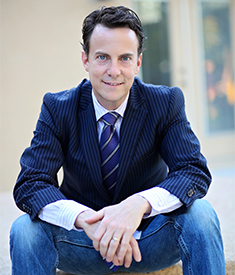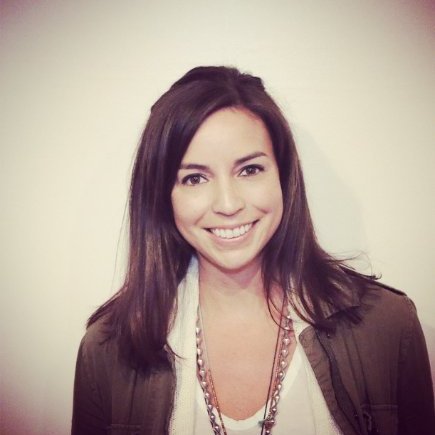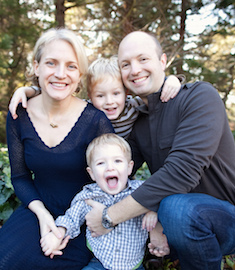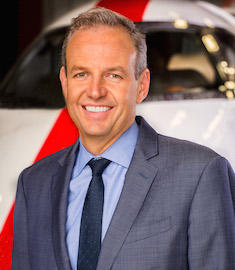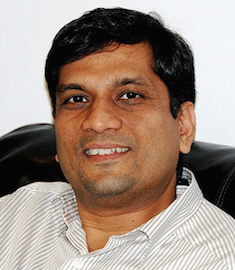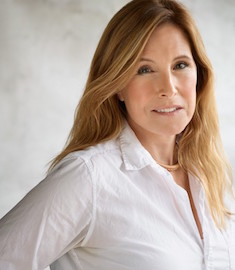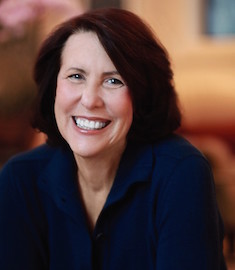Letter From Sun Valley: How Two Days with the Tugboat Institute Changed Me and My Company
I recently wrote in the Evergreen Journal about a phrase that crossed my mind as I drove from the airport in Boise, Idaho, to Sun Valley to spend a few days at the Tugboat Institute Summit 2015 in early July. The phrase is from a proverb in the King James Bible, and my old boss, Steve Forbes, has taken it as his motto: “With all thy getting get understanding.”
I can honestly say I came away from the Summit with an extraordinary number of fresh ideas, insights and perhaps even some of that rarefied understanding. And I wanted to write a personal note about the experience for Tugboat Institute members who weren’t able to attend, as well as for other business owners who’ve been on the fence about joining the Institute. If, like me, you’re intrigued by the Evergreen concept and by the Institute’s events, I hope this note will fuel your curiosity and prompt you to join and participate in the future.
As a writer and a bureau chief at Forbes for 12 years, I spent half my working life learning about, writing about and critiquing—often in acid terms—other people’s businesses. Now, I’m a business owner anxiously bootstrapping his way through year five of running a firm upon which an increasing number of families depend for their livelihood. How much understanding did I get at Forbes? I can cheerily admit it: not nearly enough.
For somebody like me, the Summit was manna. This was an intimate group, a collection of 70 people—mostly fellow CEOs and thought leaders—who arrived ready to unplug from their workaday responsibilities and speak openly and freely in a collegial environment. No press. No entourages. Just a community of businesspeople who, whether their businesses’ revenues were $5 million or $1 billion, all wanted to help one another figure out how to run an Evergreen business in a world that sometimes only seems to value go-for-broke ideals.
The theme of this year’s Summit: People First. It’s one of the 7P’s that Evergreen companies consider sacrosanct. The Summit was stacked with speakers to answer every question that has ever plagued me about how to create a healthier company of employees.
How could I do better at hiring and motivating great people? Here was Quest Nutrition president Tom Bilyeu to explain how he makes interviews really meaningful. How should I get employees to care about the bottom line? Here was SRC Holdings chief executive Jack Stack to explain how he opens his books to his people—and relies on them to help him keep his P&Ls and balance sheets healthy. How should I keep my most senior people from getting poached by competitors or leaving to start their own firms? Here was Zingerman’s Community founder Paul Saginaw to explain how he encouraged his former deli employees to cofound a dozen businesses that have expanded the Zingerman’s empire.
How should I help my people balance their work lives and their family lives? Here was noted psychologist David Surrenda to explain how to make the limited number of hours we get with our families count more. What would a workplace that gets the most out of employees look like? Here was author and Great Place to Work founder Robert Levering to talk about how it isn’t really about the perks, but rather about trust.
And on and on. There’s an art to learning, of course. To prime our neurons, readying them to absorb the flurry of mind-bending ideas, Tugboat CEO Dave Whorton pulled out all the stops. On the first evening, Dave got Tugboat Institute cofounder Chris Alden, a master puzzler, to put together a series of scintillating riddles that my teammates and I had to work together intensely to solve. The next day, after an intense morning of workshops, Dave had champion mountain biker Rebecca Rusch and world-famous mountaineer Ed Viesturs lead us on a challenging trail ride or hike in the heat. It was all in good fun, but the intensity was real. We were being pushed out of our safety zone, all the way to that unsettling edge where old assumptions look a little less safe and learning becomes possible.
By dinner on our second night, I was deeply inspired. As singer-songwriter Caitlin Canty played her guitar and sang, I looked around the room and made eye contact with a few of the extraordinary people I’d been spending time with. I realized these weren’t just fellow businesspeople—they were new friends. They were people I would look forward to seeing again and again in future years. It was a moment I will never forget.
One of the most exciting developments took place on the third day. In an informal discussion led by Dave’s team, we talked about how members of our Tugboat Institute community could end up becoming a source for one another of not only wisdom, insights and inspiration, but also permanent capital: Evergreen backing Evergreen.
When I first encountered Dave, I was intrigued by his description of the ideals of Evergreen business. Putting people first? Pacing growth? Seeking pragmatic innovations? Emphasizing private ownership? I hadn’t realized there were many serious businesspeople who still valued such things. And as Dave explained his plan to make the Tugboat Institute a touchstone for such business owners, I was electrified.
It so happened my own firm had received a takeover offer from a much larger, established firm just weeks before Dave and I met. I was uncomfortable with the notion of selling, yet I had felt enormous pressure to take the deal as a way of ensuring our continued rapid growth. Two weeks after meeting Dave, I rejected the offer. My firm is doing fine—and I’m a new member of the Tugboat Institute. We’ll use the lessons I’ll learn from my fellow Tugboat members at future Summits in Sun Valley and other events to keep the company on a sustainable, Evergreen path.
Remember that proverb snippet that was running through my head en route to the Summit? Since returning from Sun Valley, I’ve looked up the full quote: “Wisdom is the principal thing; therefore get wisdom: and with all thy getting get understanding.” In the wake of the Summit, I’m more sure than ever that I’ll never consider a buyout offer. I don’t need an acquirer’s money to overcome the challenges my firm faces. It’s new wisdom that will ensure my firm’s survival. And someday I hope to share my own hard-won wisdom with both my firm’s senior management and with new friends from other Evergreen companies.
Culture Is The Water We Swim In Every Day
I have a favorite quote from author David Foster Wallace that I feel speaks directly to company culture:
“There are these two young fish swimming along and they happen to meet an older fish swimming the other way, who nods at them and says, ‘Morning, boys. How’s the water?’ And the two young fish swim on for a bit, and then eventually one of them looks over at the other and goes, ‘What the hell is water?’ ”
Culture is the water we swim in every day.
Say you’re the CEO of a small business that has grown to the point where not everyone knows one another. You notice an increasing number of conflicts between different teams. You’ve read a lot of articles that suggest a strong company culture is the solution to these types of growing pains. But what, exactly, do we mean when we talk about culture?
Culture is something we tend not to think about because it surrounds us all the time. It is a set of organizational values that unites employees with a common purpose and a shared set of priorities. All organizations have a culture. The question is whether you know what water your company swims in—and if you can use it to your competitive advantage.
Company culture is often ignored as a strategic asset because it’s difficult to define and quantify. Much of today’s media coverage confuses culture with manifestations of culture such as brand attributes, free lunches and unlimited vacation.
Think about companies like Google and Twitter that are renowned for their cultures. What comes to mind? Maybe ping-pong tables? Maybe groundbreaking innovation? The hype ends up being about superficial trappings or specific attributes.
What’s more, Google and Twitter are like the prom king and queen of company culture. Other companies chase these cultures instead of finding their own.
So how should an Evergreen CEO define company culture? At Pomello, we propose a model based on three principles:
1) Align culture with business strategy. Identify the authentic values that drive behaviors that will make your team successful and don’t worry about emulating the company that just got written up in Forbes or TechCrunch.
2) Build cohesion by living your values and hiring for fit.
3) Measure success by evaluating culture over time and be open to changes dictated by shifting strategy.
Netflix arguably started the current wave of interest in company culture. In a now-famous 124-slide PowerPoint presentation, CEO Reed Hastings explained the firm’s values by highlighting specific behaviors it rewards (for example: employees who take smart risks demonstrate the value of courage). His value statements weren’t meant to impress; they were meant to paint an accurate picture of Netflix. They were authentic.
A second company I like to highlight for the cohesiveness of its culture from top to bottom is First Republic Bank. Its culture of customer service is embodied by its employees—from the executive team to the frontline customer relationship associates. It is unusual to see such consistency across an organization. I attribute that to a commitment to hiring and promoting staff members who best fit the culture.
Finally, I want to draw attention to SAS, another pioneer of strategic company culture. CEO Jim Goodnight once said, “My chief assets drive out the gate every day. My job is to make sure they come back.” SAS successfully structures its culture of creativity and well-being to yield results that are valuable for the firm. While the majority of the software industry experiences turnover above 15 percent, SAS’s turnover is consistently in the low single digits. This extraordinary retention rate both reflects and contributes to a healthy corporate culture.
When you have an authentic and cohesive set of values, lived by leadership and rewarded in employees, you achieve the organization-wide equivalent of charisma—a magnetic quality that draws people in. At the company level, culture attracts the right talent, keeps them engaged and optimizes your most valuable asset.
Catherine Spence is co-founder and chief product officer at Pomello (www.pomello.com), a predictive HR analytics company based in Silicon Valley.
Know What You Want
But what do you want?
The summer my son turned 7, he told me he wanted an i-something for his birthday present. His friend Mark had an iPod, his friend Noah had an iPad and he saw that I had an iPhone. He wanted an i-something.
I didn’t know what to tell my son about his i-something request. I thought he was a little young for an i-something. So I asked one of my mom friends for advice. She shared a mantra that she heard from her mother whenever she wanted something that her friends had but that her mom didn’t think she was ready for: Every family is different. It’s not defensive. It’s not an excuse. It’s just that every family has its own circumstances, its own agenda and its own history.
So does every company.
When I got out of business school, I was wired to think that my mission as a CEO and a co-founder was to maximize shareholder value. We had a deeper mission at our kids clothing company, Tea— to inspire global connection and curiosity for families. But we still obsessed over creating shareholder value.
We had an investment banker come in to tell us what our company was worth and how we could make the most money for our investors. We told him about our company—the way our design team members travel around the world, immersing themselves in culture, and then bring a little bit of the world back with them—and about our steady growth and profitability. He took all the information, made a spreadsheet and looked at comparables. When we went over his findings, he started by asking us just one question: Why do you have single-digit EBITDA?
He thought that either we should be seeing double-digit profits or we should be spending every penny on shoot-for-the-moon growth. It was totally puzzling to him why we would operate this way. I had the same answer I had for my son: Every family is different.
At Tea, it goes back to where Emily Meyer, my co-founder, and I come from. Emily’s mom grew up in Texas in a big family that didn’t have a lot of money. But in 1963, as a 21-year-old student, she traveled to Canada and Europe to study. She was away from home for a year and a half. When she returned to Texas, it was by cargo ship because she couldn’t afford normal passenger fare. From hearing about her mom’s adventures—and her mom’s determination to make something she valued greatly actually happen within her means—Emily learned the power of exploring. She learned how to make the foreign a little more familiar. (Emily’s mom recently hiked the Camino de Santiago on her 70th birthday.)
My dad was an IBM man from the moment he interviewed (at his fraternity house at Ole Miss) until the day he retired, 26 years later. When we started Tea, he couldn’t give me much advice in the ways of Silicon Valley, but he told me what he’d learned in all his years at IBM. He said if we could make a great product that customers love, and we could make a profit, everything else would work out.
We make great products that our customers love, products that bring the world into our customers’ lives and homes. And we also make a profit. We use some of it to grow our business, but we want to have enough so that we can always make our own decisions.
That’s what we want.
I taught the business plan class at Stanford Graduate School of Business for a few years, and almost every student came in thinking there was just one path: You come up with an idea, you schedule a meeting with venture capital and you draw out your business plan on a napkin. The next thing you know, you’re going public, and it’s a grand success.
I used to tell my students that before they march down Sandhill Road, they really need to know what they want. Of course they want to start a business, but they have to figure out what that means for them, for their family and for their company. I’m always repeating that to them: Know what you want. Know what you want. And I’m telling myself that, too. We have to know we don’t just want an i-something. We want to build something great.
For me, that’s an Evergreen company that will someday mean more to my sons and my sons’ children than that i-something ever did.
Leigh Rawdon co-founded Tea Collection in 2002. The San Francisco-based children’s clothing company is inspired by global cultures and modern design and dedicated to ethical sourcing and giving back. Rawdon received her BA in English from Davidson College and her MBA from Harvard. Travel is important to Rawdon, Tea’s CEO. Everyone who works at the company receives an annual international travel allowance.
Ignore Your Company's Culture - At Your Own Peril
Ignore your company’s culture—at your own peril.
At JetSuite, my Evergreen company of private chartered jets, this motto is more than just a saying. Our livelihood and our clients’ lives depend upon us having the right philosophy and making sure every one of our pilots espouses it.
Our people are our secret sauce.
But when we started this company, back in 2006, I had a different opinion. My board members, investors and I spent three years incubating and waiting for our new state-of-the-art, superefficient airplanes to be built. And at that time, we thought our secret sauce was the Phenom, an airplane that was about half the capital cost of our competitors’ airplanes. It is still expensive, but relatively speaking it was, and is, an economical game changer.
It turns out pilots are actually way more expensive than airplanes. The costs of employing, training and accommodating our pilots outweigh the capital costs of private jet airplanes by a factor of two.
We focused very, very diligently on our culture when we started the company. Usto Schulz, our founding director of safety, first introduced me to the idea that a company with an unintentional culture can be a dangerous one. Culture is how your people feel about your company. And in our case, our customers trust us with their lives every day. We need to make sure we cultivate a culture that promotes not just service but also safety. The two can sometimes appear to be in opposition—for example, when a customer insists on landing even though the conditions are unacceptably dangerous.
Now think about our biggest group of employees: They are pilots whom we typically see only a few days, twice a year, when they come in for training. We have the ultimate remote workforce. How do you maintain a culture among people that you never see—and who are often the only people who ever actually see your customers? This is very tricky to do and very important to get right.
Our culture is our character. Our character is our company. And our character is also our destiny. Starting around 2010, we spent a lot of time choosing our core values in a very protracted process. We involved every single person who was in the company at year two. We asked them to think about their mentors and people who were important to them, and to identify what it was in those people that they valued. And our company values came out of that. We took the biggest terms and distilled them into actionable statements. We wanted values that were clear and understandable. (You can see the results here.)
These values form the cornerstone of how we do business. Our vision and our mission is to make private jet travel available to more people than ever. And we’re pulling it off. We’ve got a long way to go to make it even more affordable, but among nationwide brands we’ve cut the costs roughly in half, and we’ve provided private jet rides for as little as $499 to thousands of people through our innovative marketing of last-minute “Suite Deals,” flights that would otherwise have flown empty. That alone has made JetSuite more popular on Facebook than the rest of the industry combined!
But it’s not just what we do. It’s how we do it that actually makes a big difference. We created our values, and we set about inculcating them in every single part of our business. We do this particularly in our hiring process. We need to make sure we bring in only pilots who fit our culture—and we are very diligent in making sure we get the right people.
To find them, we modified a process called Targeted Selection that was started by the U.S. Army Air Force in World War II. They had to get a lot of pilots trained in a very short period of time, and figure out who could do it and who couldn’t, so they calculated personality traits that successful pilots, and successful people, tend to exhibit.
The process takes an entire day. Potential JetSuite pilots spend part of it in a conference room chatting with all the other candidates, asking questions and being observed by one of our chief pilots. They are formally interviewed by two different people, one pilot and one nonpilot, and both interviewers have to agree to the hire. They are then invited to a cocktail party along with the whole company to see how they handle drinking and socializing in an informal environment. You’d be surprised how many candidates get drunk at the end of the day. Those folks? They don’t get hired.
When we set down the philosophy for what became JetSuite, we didn’t talk about exit strategies. We didn’t talk about going public. We didn’t talk about getting any kind of cash return instantly because we decided we were in this to build something real and to build something good. We didn’t know it at the time, but we wanted to build something Evergreen.
We did, however, talk a lot about culture and about our core values.
Every business is tough. Ours in particular is sensitive in every possible way. It’s capital intensive: We need lots and lots of money to buy airplanes. It’s labor intensive: Every single airplane requires at least two pilots, and five if you want to staff it seven days a week. We’re commodity intensive, acutely affected by the price of fuel. We’re highly regulated. And there are other factors that are out of our control, like weather, customers’ attitudes coming onto the airplane and our pilots’ attitude the morning of a flight. We have very demanding clients who pay a lot for our service and deserve the very best. And of course, we have their lives in our hands for a part of their day.
To overcome all these externalities, we need an always dependable team operating according to an agreed set of values.
How are we doing? We’ve doubled our revenue every year for the last three and a half years running. We’ve got Evergreen investors who understand that while the path may not always be straight, we are all in it for the long haul.
And our culture and our core values reflect what we think has contributed most to our company’s growth over the last five years—how our people engage with our customers and one another.
JetBlue and JetSuite co-founder Alex Wilcox has over two decades of experience creating innovative air carriers that have improved travel for millions. With JetSuite, a private airline that launched operations in 2009, Wilcox brought new technology and unprecedented value to an industry in dire need of both. Wilcox, who now serves as JetSuite’s CEO, has been named a Henry Crown Fellow by the Aspen Institute.
Evergreen Leaders Need To Be Selfish Every Single Day
Be selfish. For one hour a day.
Your Evergreen company depends on it.
The most successful leaders I’ve coached over the years have a linchpin habit. This is something they do every single morning that launches a prosperous day. I call this the “hour of power.” It involves a combination of healthy eating, mental focus and physical movement.
For breakfast, do your best to consume a whole-food combination of lean proteins, healthy fats and complex carbohydrates to build the perfect and powerful combination of serotonin, dopamine and acetylcholine — these are brain compounds that support positivity, motivation and focus.
In addition to eating a nourishing breakfast (which can be kept simple), take the time during this hour of power to partake in your favorite exercise for 20 to 30 minutes, visualize your goals and write in a journal. I also recommend meditation. For people new to this idea, you can find hundreds of easy, guided meditations online that will help get you started. Ideally, set your intentions for five minutes and work solely on being conscious of your breath. Over time, try to build to 20 minutes every morning. Meditation builds the size and power of your brain’s gray matter, which makes for more brilliant, creative and courageous thinking. It also lowers stress hormones and reduces systemic inflammation, thereby slowing down the aging process and reducing your risk for chronic disease.
If you don’t have a full hour in the morning — and I highly recommend not skimping on sleep — here is an abbreviated 10-minute version of the hour of power. Do two minutes of visualization, two minutes of movement, two minutes of meditation, two minutes of journaling and two minutes of eating an avocado. Before bed, try to add in another 10 to 20 minutes of meditation to calm your mind and help build your natural sleep chemistry.
Obviously, being healthy in this capacity is better for you as an individual. Physical and mental health helps you feel happier, more positive and more energetic. But how does an hour of power affect your Evergreen company’s team, your customers, your suppliers and other key stakeholders?
Science tells us that people are wired neurologically to connect with emotional energy. All human beings are equipped with something called mirror neurons. These are neurological copycat systems. When we are near someone oozing positivity and presence in the moment, we emulate it. This fosters trust and creativity. If we have a leader who is modeling health, happiness and conviction, we will mimic it. If our leader is an overweight smoker who is miserable on the job — even if he says otherwise — well, I think you can guess the outcome. A famous Harvard study shows that positivity is contagious: A happy person increases their next-door neighbor’s chance of being happy 34 percent.
So focusing on yourself first is imperative as you build a lasting company. But please don’t overintellectualize this notion: There is no need for you to try to become a mirror-neuron ninja. Just focus on becoming a person of great character and well-being for the sake of lifting your own mood and creative energy, and let these actions translate the message through passive example to your team. By the way, your wave of self-care will also have a positive effect on your immediate family. Research shows that our vitality, positivity, character, confidence, kindness and love are powerful influences that can improve their chances of becoming more successful, happy and fulfilled. Simply being awesome is contagious.
And while the hour of power is tremendously important on a daily basis, it’s equally important for you to allow your own neurons the opportunity to mirror inspirational behavior of other value-aligned leaders. Welcome to the tribe of genius that is this Evergreen community. By connecting with other Evergreen leaders attending the Tugboat Institute Summit this summer, you are giving yourself an opportunity to mirror the courage, inspiration, values, ideas and commitments of a group of people you admire. Show up as a contributor, step outside of your comfort zone and give your best self into that place of service, learning, community and involvement.
When you return to your life Monday morning, you will carry this epic sense of community and positive energy back to your office. There it will flourish among your immediate colleagues and spread from there.
Outliers in leadership who do things that are unconventional need to nourish and stretch themselves every single day. So take time for your own daily hour of power. It’s worth it.
Dr. James Rouse is a naturopathic doctor, entrepreneur, trainer, author, nutrition consultant, impassioned athlete and Ironman competitor. He is well known for his “Optimum Wellness” TV segments and for serving as QVC’s Wellness Specialist for several years. Dr. Rouse has written 11 books, including the recent “Think Eat Move Thrive: The Practice for an Awesome Life,” co-authored with his wife, Dr. Debra Rouse.
Without Investors, Our Evergreen Business Thrives
There’s a point in the life of every business when you have to decide if you are going to take a risk or play it safe. There’s nothing wrong with playing it safe. Plenty of businesses have chugged along with fine profits for decades by sticking to the safest path. But if you want to grow, you have to take that risk.
As the chief operating officer at Barrett Distribution, a third-party logistics company, I’ve come to this crossroads many times. While I relish making big decisions, running an Evergreen family company comes with the added pressure of continuing the family legacy.
For example, in 1995, we landed a giant food distributor. At the time, we were an $800,000 company. With this new client, we were about to double our business.
In order to accommodate this distributor, we needed another 20,000 square feet of warehouse space. Instead of buying a building that was just big enough, my brother Arthur and I (who co-run Barrett Distribution) signed a lease on a 60,000-square-foot building, funded by cash flow.
I remember signing the lease that cold New England day and thinking, “Oh, boy. What did we just do?”
But the risk paid off. The bigger warehouse gave us the confidence to go after more customers, and soon we had enough business to fill the space. We have grown from a $600,00 company to a $55 million company with 275 employees and locations in six states. We’ve been able to grow without taking investor money by trusting our own instincts and taking smart risks.
Barrett Distribution was founded by my grandfather 75 years ago as a wool warehouse serving the textile factories around Lawrence, Massachusetts. My father grew the company to deliver bulk goods to local manufacturing plants. When he passed away in 1984, I was still in college. My mother ran the business for a time, and then my brother stepped up to take over.
When I was getting my MBA at the University of Michigan, I knew I didn’t want to go work for a large corporation. I wanted to be more entrepreneurial. After several interviews, I realized there was a great opportunity right under my nose — the family business.
I joined Barrett Distribution in 1994. At the time we had five employees and were doing a comfortable $600,000 per year, but my brother and I felt we could do better.
It was both a blessing and a curse that my father wasn’t around to help us. It would have been invaluable to have had the wisdom of his decades of experience as we set out to grow the company. At the same time, I’m not sure my dad would have been completely supportive of our appetite for risk.
We’ve tried to be very calculating about risk. For the most part, we’ve grown steadily, adding warehouse space and employees to meet our clients’ needs. Until about six years ago, we never took on any debt. There were times we weren’t taking salaries, but we were able to fund our growth through cash flow. (Low interest rates finally convinced us that it made sense to take on some debt, but we still keep our debt-to-equity ratio very low.)
Because our risks tended to pay off, I was full of confidence when we took on our biggest customer to date in 1998. We were a $2 million company — not even the biggest logistics company in Boston. But when Best Buy went looking for a partner to manage its distribution, we landed the business.
Best Buy was a $3 million client, which meant we had to grow quickly. For the first six months, my brother and I worked 100-hour weeks to handle the extra work. Best Buy didn’t just bring more volume; it created a level of complexity we hadn’t worked with before. We were lucky to hire the perfect manager to run the new operation and, in less than a year, Barrett had grown enough to comfortably manage the business. Looking back, I may have been overconfident in our abilities to handle such a big customer. But it never occurred to me that we wouldn’t be successful.
Best Buy was a game changer for Barrett. The marquee name brought in a lot of new business (although we never used the company in our marketing) and we were able to grow steadily into our current national footprint. (Best Buy now does all of its logistics work internally.)
And we are still a 100% Evergreen family-owned business. We get offers all the time from companies wanting to buy Barrett. But I always think about how much more we’re going to be worth in five years or 10 years if we keep growing on our own. We never would have been able to get here if we had to answer to outside investors. They may have advised us to be cautious or to spend more time deliberating every move. On our own, we have more flexibility, and that has driven our success.
Instead of pleasing investors, I’ve been able to make my decisions with the best interests of my family, my employees and my business in mind. We feel like we have a good thing going here and the future looks bright.
Tim Barrett is Chief Operating Officer of Barrett Distribution Centers. He has served as President of the Council of Supply Chain Management Professionals’ New England Roundtable. Before joining Barrett Distribution, Tim held positions at PriceWaterhouseCoopers. Tim received his M.B.A. from The Ross School at The University of Michigan and B.A. in Economics and Accounting from The College of the Holy Cross.
Employers Should Stop Seeking Formal College Credentials
College is expensive and it keeps getting worse.
Tuition and fees at public colleges have climbed faster than inflation, rising 17% over the past five years to an average $9,139 per year. That’s not including the price of room and board. Students are leaving four-year schools with an average $28,400 of debt and entering a job market that is recovering, but still presents plenty of challenges.
The common consensus is that the higher-education system must fix itself. There is a workable alternative: Employers should stop requiring formal credentials wherever the law doesn’t mandate them for a job.
This might sound like a crazy idea but it’s not. At my company, Zoho, about 15% of our 2,500 employees do not have college degrees. We are a privately held cloud software provider, and because we plan to stay private and don’t have to answer to outside shareholders, we have the freedom to experiment with new ways to build our workforce.
We’ve had incredible success hiring workers right out of high school. Recruits spend 18 months in a rigorous hands-on program that is part apprenticeship, part education. About 90% of the incoming students graduate and become full-time employees who get placed on one of our software product teams. The success of the program has given us a high-quality workforce that is passionate and dedicated. Our employees give Zoho a major advantage in our hypercompetitive industry.
We started with a modest program nearly a decade ago, when we recruited six students from nearby high schools in our Chennai, India, office and trained them in software development. This year we had 90 students in our incoming class in two different locations — one in India and one in the U.S.
Companies interested in adopting our model should start with a small pilot program — about five to 10 students working with one or two experienced teachers (who should ideally come from the existing workforce). The program’s faculty should consist of employees who have plenty of work experience but who are also passionate about mentoring young people. The curriculum should be very hands-on and relevant to your core business. This keeps the students motivated and helps them stay focused.
I can imagine the naysayers questioning this kind of program. Isn’t college about more than just work skills? Don’t young people need to learn to be critical thinkers who can grow into future leaders?
I agree that college is about more than just getting a good job, but the truth is that for the majority of students, a college education adds little meaningful value. Many students are unfocused when they enter college and equally unfocused when they leave — with a heavy debt that needs to be repaid, to boot. Most of us who have been through college can identify with this: How many of us can honestly say we paid attention to our classes or have any recall of what we learned in college five or 10 years out?
It is undeniable that the most important reason students pay the steep price for college is to land a good job. Our experience teaches us that we can separate out the skill-building part of education and offer it in a much more efficient and responsible way that helps both students and employers.
This idea is not as radical as it sounds. In countries like Germany, employers, through extensive apprenticeship programs, have always been a major resource for skill development. As a direct result, Germany has one of the most productive and highest-paid workforces in the world.
Teaching young workers on the job is a good thing to do in and of itself. Learning is a lifelong process, particularly for today’s knowledge-intensive workforce. It is also a good thing for employers. Employers that invest in skill development gain a competitive edge, something that our experience at Zoho amply demonstrates.
Sridhar Vembu co-founded Zoho, which provides a leading integrated suite of cloud applications for business. In a fiercely competitive market, Zoho has pioneered an alternative model of education and recruitment known as Zoho University. Zoho is a private company that has not relied on any outside funding.
In It For The Long Haul: Why I Believe In Evergreen
I guess you can say I’m old-school. I still send printed invitations via snail mail, I prefer handwritten notes over email, and I shudder when I think about wearing patent leather after Labor Day. I chose my college major (bachelor of science in textile and clothing merchandizing) because I liked to shop — to see, touch, and feel beautiful products — and felt that degree would lead most quickly to a career. I am also a creature of habit. In any new situation I start with the assumption that everyone around me knows more than I do, and I strive to learn from them through practice, patience, and perseverance.
These personality quirks help explain why the “Evergreen” path works for me. I’ve found that a clear purpose, the relentless pursuit of learning, and pragmatic innovation are vital to building a long-term, successful growth business.
I started my work life in retail, quickly moving from the sticky, calorie-laden world of a Dairy Queen counter girl into menswear retail, where I learned the intricacies of high-quality fabrics, fit, and customer service. Throughout high school and college I had the privilege of working around the finest Scottish cashmere, Sea Island cotton, and Italian leather accessories, which took years to truly understand. Rather than hopping from one mall store to another, I chose to master the category and truly learn about one very specific market segment: handbags, belts, and small leather goods.
After college, I worked for a group of department stores and chose to work with the saltiest, most experienced senior buyer, because I knew I would learn more from her than from the young, fun boss. My boss pushed me hard, but my perseverance paid off with a rapid promotion and comprehensive knowledge of the handbag industry, which I am still a part of today.
Several years later, in 1987, I moved from New York to San Francisco and joined Esprit de Corp. Having grown up with this casual, fun lifestyle brand, I couldn’t miss this opportunity.
However, Esprit did not grow and innovate quickly enough, and competitors stepped in, copying the formula at lower prices, and eroding market share. I learned two things from this experience. First, that keeping an eye on advances in your industry while still addressing your core market is essential to building an Evergreen company. No matter how brightly a company blossoms in its youth, if it does not develop the flexibility to change along with its customers, it will suffer. Second, the painful separation of its founders, which carried over into their business with disagreements about growth and innovation strategies, undermined the cohesive purpose of this once-great business.
When the opportunity came to join a fashion accessory startup with my mentor from Esprit, I reluctantly took the leap. While I had mastered many of the skills necessary to design, produce, and procure product from overseas factories, I still had doubts about some of the logistics and operations that I had never been exposed to. But I decided to jump in and once again learn by doing, so that when the time came to hire additional people, I could honestly say that I had done every job in the company.
When my mentor retired, an easy path would have been to allow him to sell the company and enjoy my share of the proceeds. However, rather than take this windfall, I made the decision to bootstrap the purchase of the company, mortgage my house, and pour everything I had into the business. Having mastered the core skills to run the business, I found this decision an easy one. I understood the purpose, I had persevered through the learning curve, and I had experienced enough bad partnerships to know that I wanted to do it on my own.
It has been ten years since I became the sole owner of G. Hensler & Co., and I don’t regret my path for a minute. Keeping it private has allowed me the flexibility to take calculated risks such as the introduction of our branded line, 49 Square Miles. It allows passion, not profit, to be the driving force. Profits are important to keep the business running and growing, but they are not our purpose. I am able to focus not only on growing a great business but also great people. I want to build a company that will flourish and embrace innovation in order to adapt as the market evolves.
I guess I really am “old-school” — I’m in it for the long haul. I choose Evergreen as the only path for me.
Lisa Rissetto designs and manufactures private-label fashion for large specialty retail chains. She also designs and sells high-end accessories under the 49 Square Miles label. Lisa has worked in fashion since age 15 and was at Esprit before co-founding G. Hensler & Co.
The Challenge To Change: It's Time To Reconsider New Models Of Success
Since Teach Your Children Well came out in the summer of 2012 I have been on a perpetual book tour. I have spoken in many of the wealthiest enclaves in this country to parents who send their children to the most prestigious independent schools. I have also spoken to parents who are squarely middle or working class at public schools that range from the notable to the unexceptional. I have spoken to top-level executives from Google and Microsoft, American Express and Morgan Stanley. I have also spoken to the boots on the ground people who work for these companies. I’ve been to Austin Texas, but also Midland Texas. To the Upper East Side of New York, the North Shore of Chicago and Beverly Hills as well as Knoxville, Nashville and Memphis. I’ve crisscrossed the country speaking to parents, teachers, administrators, professors, business executives, regular folks and billionaires. While the wealth disparity in this country is increasingly shocking, here is what has surprised me most. Regardless of where I am, and whom I’m speaking to, change – in our value system, in the way we parent, in what we expect from our children – has been consistently met with a combination of interest, appreciation, apprehension and resistance.
This mixed bag of reactions to the call for change is understandable. Change, for most of us, is hard. Change that involves our children is particularly hard. Experts throughout the country are pushing for a new way of thinking about success for our children. We’d like parents to understand that every child is different, that there is no such thing as “one size fits all” when it comes to measuring success and that the historical measures of success, grades and SAT scores, are limited in their ability to predict success for our children. We are proposing a new paradigm, one that is more closely aligned with what research tells us about child development and the best practices of educators. We’d like parents to keep the bar high for their children, but to make sure that bar is in line with their abilities, interests and well-being. We value what used to be considered “soft skills” and are now considered indispensable for healthy emotional development as well as employability. Skills like creativity, resilience, integrity, perseverance and self-motivation. We believe that we are still educating and still parenting using a paradigm that provided the heartbeat for America in the Industrial Age but is increasingly inappropriate for the needs of 21st century America. So while there is general agreement, among parents, educators and business leaders, that change needs to be made the process has been surprisingly slow and fraught with uncertainty and anxiety.
After The Price of Privilege was written in 2006 I anticipated resistance to change. After all, most of us had been unaware of the psychological toll that was being exacted on our children by our high-pressure, high-stakes educational system. Traveling around the country I found the predictable questioning of data and conclusions. “ A little stress is good for kids.” “I worked two jobs when I was a teen, it didn’t hurt me.” “Kids are resilient. They can make up sleep later.” Eight years later these comments are no longer part of the discussion. One in four high school kids have significant symptoms of either depression or an anxiety disorder. One in four college kids abusing substances. 17% of kids at the Ivies self-mutilating. A 78% increase in suicide among young girls, a 34% increase among teens in general. Parents are aware and educated about the fact that an extreme emphasis on metrics, on perfection, on a narrow version of success is working against the healthy development of their children. Almost all the questions that I am asked now have to do with how to reverse the disturbing trends, how to create a healthier paradigm and how to work as a community to effect change. While I certainly don’t have all the answers to these questions, research and common sense draw some pretty hard conclusions. Kids shouldn’t be doing 4 hours of homework a night. They need the amount of sleep recommended by the American Academy of Pediatrics (approx. 11 hrs. for younger kids, 9 hrs. for preadolescents and adolescents). Being overly focused on content often excludes the necessary development of socio-emotional skills. The effects of unsustainable levels of stress are being seen in the offices of not only mental health workers, but also internists, pediatricians, orthopedists and GI specialists. Kids now report that the greatest stressor in their lives is school.
So you’d think that we’d be clamoring for change. Insisting that our schools pay more attention to kids well-being along with educating them with an eye to the needs of the 21st century. You’d think that we’d have reconsidered the value of praise, perfection and insisting that metrics tells the whole story. But in fact, there is not picketing at our schools, no marches in the streets and only minimal changes in most of our households. We are convinced of the need to change and terrified of implementing it. We worry that if we change too quickly, while others hang onto the old paradigm, that our children may be left behind. That our changes may disadvantage our children when it comes to the intense competition we feel awaits them in school, in work, in life. If our son doesn’t join the traveling soccer team at 8, how will he be able to compete at 13? If our daughter doesn’t take 4 AP’s her junior and senior year, how will she get into a top school when her best friends are taking 5 AP’s? Can we really insist that our teens spend the summer working at Target when his friends are off to developing nations building water treatment plants and school buildings? Aren’t we depriving them of both a cultural experience and a great looking transcript?
So here’s the thing. An exhausted, frightened, stressed child is unlikely to be successful in the long run. It has always been our job, mothers and fathers alike, to first and foremost protect our children. To keep them safe. Yes it takes courage to swim against the tide, to make decisions that are not aligned with what appear to be community values, to take a risk and decide that our children are better served by being protected than by being pushed. Over and over in my office I see teens in tears because they fear disappointing their parents with a less than stellar grade or field performance. It’s time for us to step back and reconsider what we have always known. That our children are precious. That they need and deserve to be protected. That their worth can’t possibly be measured in grades or scores
Those of you who are joining the Evergreen movement, or who are just curious about it, have already begun to reconsider models of success. The fact that things have traditionally been done one way, or that others are following a particular path, are simply data points, not imperatives. There are always options. The exact questions that you are considering for your business and your life are the same questions that you should be considering for your family. What does success look like over time? What are my values? Am I really implementing those values in all aspects of my life? We know change is hard. But it is exactly this capacity to change, to create and to adapt that makes for healthy lives, healthy businesses and healthy families. There is no such thing as reconsidering your business model without reconsidering your parenting model. Healthy people are intact and integrated. You can’t be one person at work and another at home. If you want to build something enduring, something Evergreen, you have to clearly and consistently understand that what you are building has a long time horizon. Your child’s grades today are incidental compared to the importance of the person they will grow up to be 10 or 20 years down the line when they walk into their own lives, marriages and businesses. Keep your eye on the long view. On everything.
Madeline Levine, Ph.D. is a psychologist with close to 30 years of experience as a clinician, consultant, educator and author. Her New York Times bestseller, The Price of Privilege, explores the reasons why teenagers from affluent families are experiencing epidemic rates of emotional problems. Her latest book, Teach Your Children Well, also a New York Times bestseller, l gives practical, research-based solutions to help parents return their families to healthier and saner versions of themselves by remembering that successful parenting is measured 20 or 30 years down the road, not at the end of any particular grading period. Dr. Levine is also a co-founder of Challenge Success, a project at Stanford’s Graduate School of Education. Challenge Success believes that our increasingly competitive world has led to tremendous anxiety about our children’s futures and has resulted in a high pressure, myopic focus on grades, test scores and performance. Challenge Success provides families and schools with the practical research-based tools they need to raise healthy, motivated kids, capable of reaching their full potential.
Welcome To The Evergreen Journal
Why does the world need an Evergreen Journal? We have met countless entrepreneurs and executives who have too long toiled in obscurity as they build and grow great Evergreen businesses. They have no place — physical or virtual — to congregate, share ideas, and learn from each other.
For the most part, these leaders do not seek the limelight, they are intrinsically motivated. But they do hunger to get to know other executives building companies with similar mindsets and for the opportunity to learn and help influence best practices for building great, enduring businesses. The Evergreen Journal is for them. The Evergreen story needs to be told.
So what is “Evergreen”? We put it this way:
Evergreen entrepreneurs are purpose-driven leaders with the grit and resourcefulness to build and scale private, profitable, enduring, and market-leading businesses that make a dent in the universe. They measure success by how well they deliver on their mission and they embody the 7Ps: purpose, perseverance, people, profit, private, paced growth, & pragmatic innovation. [For more, please read our post on The Evergreen Movement.]
Evergreen entrepreneurs combine the passion and talent of great Silicon Valley entrepreneurs but are wary of any path that compels them to a pre-determined exit or a growth-at-all-costs approach. They are building companies to last, not to flip. Evergreen companies range from long-standing, closely-held businesses like Mars and SAS Institute, to great lifestyle brands like Peet’s Coffee, to newer growth companies such as Quest and Zoho. What they have in common is their passion to build purpose-driven, private, profitable, enduring, and market-leading businesses.
There is no standard bearer exclusively focused on this type of company — until now.
That’s why we created the Evergreen Journal, a new publication of record for the Evergreen movement — covering the people, companies, and ideas driving the Evergreen approach to company building. Our purpose with the Evergreen Journal is to tell stories about and share insights from Evergreen exemplars (sometimes in their words, sometimes in ours) to help the community learn from each other and grow. We also believe that a broader general awareness of the Evergreen idea will help nurture a growing base of talent, customers, partners, and service providers who want to work for, buy from, partner with, or provide services to Evergreen businesses.
Today, there are plenty of publications that cover the venture backed startup world, and one could spend every day of the year at different tech/startup event if one had a penchant for stale coffee, big pitches, and small talk. But very little is written about and for the Evergreen mindset. A major difference between these publications and Evergreen Journal is, of course, that EJ isn’t much interested in who is funding what company at what valuation but we will cover the business and personal side of Evergreen.
The Evergreen Journal will be written by, for, and of the Evergreen community and will be a platform for Evergreen leaders to share their thoughts, views, and insights with the community. We already have almost two dozen guest writers lined up and we encourage any Evergreen leader with something of value to bring to the community to get in touch and make an editorial contribution.
While we, by definition, narrow our focus on the types of companies we write for and about, we are broadening subject matter. In addition to our two initial articles from Tom Bliyeu of Quest (Inc. 500’s second fastest growing private company) and Roger Thornton (serial entrepreneur who is “Green with Envy”), we will publish in our next edition a moving article from NYT best-selling author and child psychologist Madeline Levine and next month you’ll find tips on how thrive in the quest for genius, by Dr. James Rouse. It’s time we stop pretending that there is a hard line between business and life, and explore how to thrive in both — and understand how each supports and shapes the other.
So, we publish this in service of you — the reader — in the hopes that it will provide knowledge, insight, and ideas that will help you professionally and personally and that it will encourage the evergreen community to come together and continue to blossom.
This is the first step in an uncertain and winding journey and we invite anyone with an interest in the Evergreen movement and something valuable to contribute to get in touch, give us your feedback and guidance, point us in the directions of great evergreen people, companies, and ideas, write letters to the editor, and throw your hat in to be a contributor.
Co-create this with us!
